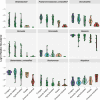Nepali oral microbiomes reflect a gradient of lifestyles from traditional to industrialized
- PMID: 39497165
- PMCID: PMC11533410
- DOI: 10.1186/s40168-024-01941-7
Nepali oral microbiomes reflect a gradient of lifestyles from traditional to industrialized
Erratum in
-
Correction: Nepali oral microbiomes reflect a gradient of lifestyles from traditional to industrialized.Microbiome. 2024 Dec 3;12(1):252. doi: 10.1186/s40168-024-01988-6. Microbiome. 2024. PMID: 39627806 Free PMC article. No abstract available.
Abstract
Background: Lifestyle plays an important role in shaping the gut microbiome. However, its contributions to the oral microbiome remain less clear, due to the confounding effects of geography and methodology in investigations of populations studied to date. Furthermore, while the oral microbiome seems to differ between foraging and industrialized populations, we lack insight into whether transitions to and away from agrarian lifestyles shape the oral microbiota. Given the growing interest in so-called "vanishing microbiomes" potentially being a risk factor for increased disease prevalence in industrialized populations, it is important that we distinguish lifestyle from geography in the study of microbiomes across populations.
Results: Here, we investigate salivary microbiomes of 63 Nepali individuals representing a spectrum of lifestyles: foraging, subsistence farming (individuals that transitioned from foraging to farming within the last 50 years), agriculturalists (individuals that have transitioned to farming for at least 300 years), and industrialists (expatriates that immigrated to the USA within the last 20 years). We characterize the role of lifestyle in microbial diversity, identify microbes that differ between lifestyles, and pinpoint specific lifestyle factors that may be contributing to differences in the microbiomes across populations. Contrary to prevailing views, when geography is controlled for, oral microbiome alpha diversity does not differ significantly across lifestyles. Microbiome composition, however, follows the gradient of lifestyles from foraging through agrarianism to industrialism, supporting the notion that lifestyle indeed plays a role in the oral microbiome. Relative abundances of several individual taxa, including Streptobacillus and an unclassified Porphyromonadaceae genus, also mirror lifestyle. Finally, we identify specific lifestyle factors associated with microbiome composition across the gradient of lifestyles, including smoking and grain sources.
Conclusion: Our findings demonstrate that by studying populations within Nepal, we can isolate an important role of lifestyle in determining oral microbiome composition. In doing so, we highlight the potential contributions of several lifestyle factors, underlining the importance of carefully examining the oral microbiome across lifestyles to improve our understanding of global microbiomes. Video Abstract.
सारांश पृष्ठभूमि: मानवको आन्द्रामा ब्याक्टेरिया, भाइरस, फंगस (ढुसी), लगायत अरू विभिन्न प्रकारका सूक्ष्मजीवहरूका समुदाय पाईन्छन्, जसलाई माइक्रोबायोम भनिन्छ। आन्द्रामा हुने माइक्रोबायोमले मानवको पाचन, प्रतिरक्षा प्रणाली, र अन्य शारीरिक प्रक्रियाहरूमा योगदान पुर्याउने हुनाले यिनले मानव स्वास्थ्य र रोगको निर्धारण गर्नमा महत्त्वपूर्ण भूमिका खेल्छन्। त्यसैगरी मानव मुखमा पनि सूक्ष्मजीवहरूका समुदायहरू हुन्छन् जसले दाँत र गिजालाई स्वस्थ राख्नमा योगदान पुर्याउँछन्। जीवनशैलीले आन्द्राको माइक्रोबायोमलाई आकार दिन महत्त्वपूर्ण भूमिका खेल्छ। साथै, जङलमा निर्भर भएर प्रकृतिक जीवनशैली जिउने र औध्योगिक्रित भएका मानव समुदायहरुको बीच मुखको माइक्रोबायोममा धेरै भिन्नता देखिन्छ। जङलमा निर्भर भएर प्रकृतिक जीवनशैली जिउने मानव समुदायहरुमा पाईने धेरै सूक्ष्मजीवहरू औद्योगिक जनसमुदायहरुमा मा पाईन छाडिसकेका छन् र यस्ता ‘विलुप्त माइक्रोबायोम’ बिभिन्न रोगहरुका जोखिमका कारक हुन सक्ने हुँदा चासोका बिषय बन्न पुगेका छन्। तथापि, अहिलेसम्मका अनुसन्धानमा जीवनशैलिको परिवर्तन सँगै मुखको माइक्रोबायोममा के कस्ता परिवर्तनहरु आउँछन् भन्ने कुरा स्पष्ट हुन सकेको छैन। विभिन्न जीवनशैली ब्यथीत गर्ने मानिसहरु बीच जीवनशैलीको साथसाथै भौगोलिक भिन्नता पनि हुने गर्दछ। तसर्थ, मनिसहरुका मुखका माईक्रोबायोममा जीवनशैली र भूगोलको असरलाई छुट्याउनु महत्त्वपूर्ण देखिएको छ। परिणामहरू: यहाँ, हामीले ६३ जना नेपाली व्यक्तिको थुक संकलन गरेर मुखका माइक्रोबायोमको अनुसन्धान गर्यौं। हाम्रो अध्ययनमा संलग्न भएका ब्यक्तिहरुले विभिन्न जीवनशैलीको प्रतिनिधित्व गर्छन्: जङलमा निर्भर भएर प्रकृतिक जीवनशैली जिउने, जङलबाट कृषितर्फ हालसालै परिवर्तन भएका (अन्तिम ५० वर्ष भित्र), कृषक (बिगतका ३०० वर्ष भन्दा बढी समयदेखि कृषिमा संलग्न भएका), र औद्योगिक (अन्तिम २० वर्ष भित्र संयुक्त राज्य अमेरिका मा आप्रवासन गरेका नेपालीहरु)। हामीले यस् अध्ययनमा जीवनशैलीले मुखका माईक्रोबायोमको विविधतामा कसरी योगदान पुर्याउँछन् भन्ने कुरको विश्लेषण गरेका छौं, जीवनशैलीहरू बीच फरक पर्ने सूक्ष्मजीवहरूको पहिचान गरेका छौं, र माइक्रोबायोममा फरक पार्ने कारकहरूको पहिचान गरेका छौं। प्रचलित दृष्टिकोणहरू विपरीत, भूगोललाई नियन्त्रण गर्दा, बिभिन्न जीवनशैलीहरू बीच मुखको माइक्रोबायोममा हुने सूक्ष्मजीवहरूको सन्ख्या (अल्फा विविधता) मा धेरै फरक देखिएन, तर मुखको माइक्रोबायोमको संरचना भने जीवनशैलीको क्रमिक चरणसँग मिल्दोजुल्दो देखियो, जसले देखाउँछ कि जीवनशैलीले मुखको माइक्रोबायोममा को संरचना निर्धारण गर्न एउटा प्रमुख भूमिका खेल्दछ। स्ट्रेप्टोबासिलस र असम्प्रेषित पोरफिरोमोनाडासिए जीनस सहितका केही सूक्ष्मजीवहरूको सापेक्ष सापेक्षिक प्रचुरता पनि जीवनशैलीसँग मेल खाने हामीले यस् अध्ययनबाट थाहा पाएका छौं। अन्ततः, हामीले जीवनशैलीको क्रमिक चरणमा माइक्रोबायोम संरचनासँग सम्बन्धित विशिष्ट जीवनशैलीसँग आबद्ध हुने धूम्रपान र अनाज जस्ता कारकहरूको पहिचान गरेका छौं। निष्कर्ष: हाम्रा निष्कर्षहरूले प्रष्ट परेका छन कि भूगोललाई नियन्त्रण गर्दा, हाम्रो जीवनशैलीले हाम्रा मुखको माइक्रोबायोमको संरचना निर्धारण गर्ने महत्त्वपूर्ण भूमिका खेल्दो रहेछ। यस् अध्ययनले मानव समुदायहरुमा मुखको माइक्रोबायोमको अध्ययन गरेमा माइक्रोबायोमबारेको हाम्रो बुझाइमा सुधार ल्याउन सकिने पनि देखाउँछ। बढ्दो शहरीकरण सँगसँगै नेपालीहरुको माइक्रोबायोममा परिवर्तन हुँदै गरेको र यस्ता परिवर्तनहरुले नेपालीहरुमा बिभिन्न दीर्घकालीन रोगहरुको व्यापकता बढाउन सक्ने हुनाले यस् सम्बन्धमा उपर्योक्त निकायहरुको ध्यानाकर्षण हुनुपर्ने आवश्यकता पनि यस् अध्ययनले प्रष्ट पारेको छ।.
Keywords: Lifestyle; Nepali populations; Oral microbiome; Oral microbiota; Salivary microbiome.
© 2024. The Author(s).
Conflict of interest statement
The authors declare no competing interests.
Figures







Update of
-
Nepali oral microbiomes reflect a gradient of lifestyles from traditional to industrialized.bioRxiv [Preprint]. 2024 Jul 3:2024.07.01.601557. doi: 10.1101/2024.07.01.601557. bioRxiv. 2024. Update in: Microbiome. 2024 Nov 4;12(1):228. doi: 10.1186/s40168-024-01941-7. PMID: 39005279 Free PMC article. Updated. Preprint.
References
-
- Hublin J-J, Ben-Ncer A, Bailey SE, Freidline SE, Neubauer S, Skinner MM, et al. New fossils from Jebel Irhoud, Morocco and the pan-African origin of Homo sapiens. Nature. 2017;546:289–92. - PubMed
-
- Clarke SF, Murphy EF, O’Sullivan O, Lucey AJ, Humphreys M, Hogan A, et al. Exercise and associated dietary extremes impact on gut microbial diversity. Gut. 2014;63:1913–20. - PubMed
MeSH terms
Substances
Grants and funding
LinkOut - more resources
Full Text Sources

